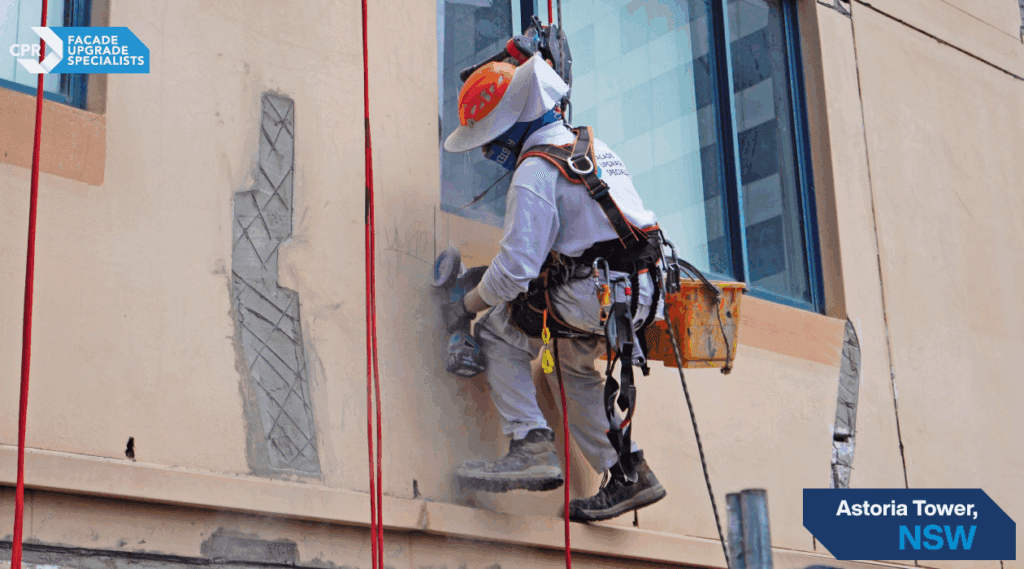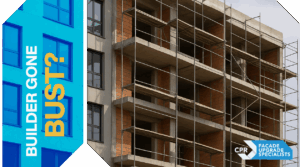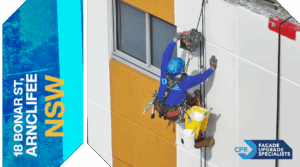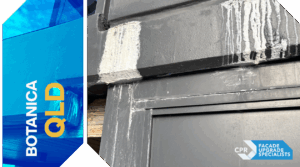Concrete spalling is a critical issue faced by many high-rise and strata buildings across Australia. It is one of the leading causes of structural deterioration in reinforced concrete, often known as concrete cancer. This comprehensive guide on Concrete Spalling: All You Need To Know explains what concrete spalling is, what causes it, how to recognise it, prevention methods, and the most effective repair solutions. Whether you’re a strata committee, building manager, or consultant, understanding concrete spalling is essential to maintaining the safety, value, and appearance of your building.
At CPR Facade Upgrades, we bring 30+ years of experience, using Scaffold-Free™ access systems such as MARS™, PEARS®, and SkyPod®. Combined with SKY-FIMMS™ digital twin inspections, we deliver precise, affordable, and long-term solutions with significant cost savings compared to scaffolding.
What is Concrete Spalling?
What is concrete spalling? It occurs when the surface of reinforced concrete breaks away, flakes, or crumbles, usually because of corrosion of embedded steel. Many call it concrete cancer (spalling) because it spreads if untreated. This isn’t just a cosmetic defect—it directly impacts the structural integrity and spalling risk of a building.
Spalling concrete is most dangerous in high-rise and difficult-to-access façades. Falling debris threatens public safety, while untreated cracks allow deeper deterioration. For owners, the result is increased liability, higher repair costs, and loss of building value.
What Causes Concrete Spalling?
Understanding concrete deterioration causes helps in preventing costly future issues.
Steel Corrosion Spalling
The number one culprit is steel corrosion spalling. As steel rusts, it expands, forcing the surrounding concrete to crack and detach. This is why exposed reinforcement is a red flag.
Fire Exposure Concrete Damage
Fire exposure concrete damage weakens the matrix of the concrete and leads to rapid spalling under extreme heat. Basements, plant rooms, and fire-affected buildings are at risk.
Freezing and Thawing Damage
In regions exposed to weather extremes, freezing and thawing damage creates internal stress, causing cracks and scaling.
Chemical Reactions in Concrete
Chemical reactions in concrete, such as alkali-silica reaction, destabilise structures and accelerate spalling.
Other Causes of Spalling
- Inadequate concrete cover over steel reinforcement
- Poor construction methods
- Water ingress from roof membranes and joints
- Lack of protective coatings or sealants
How to Recognise Spalling Concrete
How to recognise spalling concrete is crucial for early intervention. Look for:
- Signs of damaged concrete such as flaking patches
- Rust stains on walls and ceilings
- Cracks or bubbling on painted surfaces
- Exposed or corroding reinforcement steel
- Hollow or drummy sounds when tapping surfaces
Spotting these early prevents the need for major structural remediation.
Can You Prevent Spalling Concrete?
Yes, proactive maintenance reduces the likelihood of damage. Can you prevent spalling concrete? The answer is a strong yes with the right plan.
Concrete Maintenance Tips
- Regular painting of ceilings protects against moisture penetration.
- Seal holes and cracks to stop water reaching reinforcement.
- Ensure adequate ventilation in basements and service areas.
- Apply the best sealants for concrete protection such as silane or siloxane.
- Use waterproof membranes for exposed façades.
At CPR, our AssetCare™ long-term preservation program delivers multi-decade durability, which means for you fewer unexpected repairs and better protection of property value.
How to Repair Concrete Spalling
How to repair concrete spalling effectively requires technical expertise and the right systems.
Spalling Concrete Repair Methods
- Inspection and Mapping with SKY-FIMMS™ – We quantify every defect, providing accurate repair volumes.
- Concrete Removal – Removing delaminated areas until sound concrete remains.
- Steel Treatment – Cleaning and applying corrosion inhibitors to reinforcement.
- Patch Repairs – Using high-quality mortars or epoxy repair for concrete spalling in critical areas.
- Protective Coatings – Applying long-lasting sealants for future protection.
Concrete Surface Damage Solutions
From spalling vs scaling concrete to reinforced concrete spalling issues, CPR provides proven concrete surface damage solutions. While scaling is often surface-related, spalling indicates deeper structural deterioration that requires professional concrete restoration services.

Cost of Repairing Concrete Spalling
The cost of repairing concrete spalling varies by severity, but one factor remains consistent: scaffolding inflates costs. Traditional methods add up to 30% to budgets. With CPR’s Scaffold-Free™ systems (MARS™, PEARS®, SkyPod®), which means for you affordable access, faster delivery, and less disruption to residents.
Professional Concrete Restoration Services
Engaging experts in professional concrete restoration services is vital. CPR offers:
- Transparency with SKY-FIMMS™ digital twin reporting
- Scaffold-Free™ remediation with minimal disruption
- Quality assurance through Accredited Service Partners™
- AfterCare™ support for future-proofed protection
Case study: A Sydney strata committee faced millions in scaffold costs. By engaging CPR, they saved over $400,000, avoided special levies, and cut project duration in half.
Why CPR is the Smarter Choice for Spalling Repairs
- Proven expertise in concrete preservation and remediation
- Award-winning projects across strata, commercial, government, and heritage sectors
- Long-term warranties through AssetCare™
- Real-world proof from video testimonials and case studies
FAQs About Concrete Spalling
What is the difference between spalling and scaling concrete?
Spalling is caused by steel corrosion or structural issues, while scaling usually results from freeze-thaw cycles or poor finishing. Spalling indicates deeper structural damage.
Can epoxy fix concrete spalling permanently?
Epoxy repair for concrete spalling is highly durable and effective, especially for structural areas. However, long-term protection also requires sealing and waterproofing.
How much does it cost to repair spalling concrete?
The cost of repairing concrete spalling varies based on severity, but Scaffold-Free™ systems reduce costs by up to 20% compared to scaffolding.
Is spalling concrete dangerous?
Yes, spalling compromises structural integrity and spalling risk, posing safety hazards to residents and passers-by.
How can you prevent spalling concrete in buildings?
Concrete maintenance tips include sealing cracks, using the best sealants for concrete protection, ensuring adequate ventilation, and scheduling regular inspections with CPR.
Do all buildings eventually suffer spalling?
Not all, but many reinforced concrete buildings develop spalling without proper maintenance. With proactive care, including professional concrete restoration services, the risks can be minimised.
Take Action Now
Ignoring spalling only multiplies cost and risk. Protect your building with CPR’s innovative, cost-effective approach.
- Book your inspection now: CPR Facade Upgrades
- Learn about spalling concrete repair methods: Concrete Repairs & Durability
- Explore facade remediation and preservation services: Facade Remediation & Preservation






